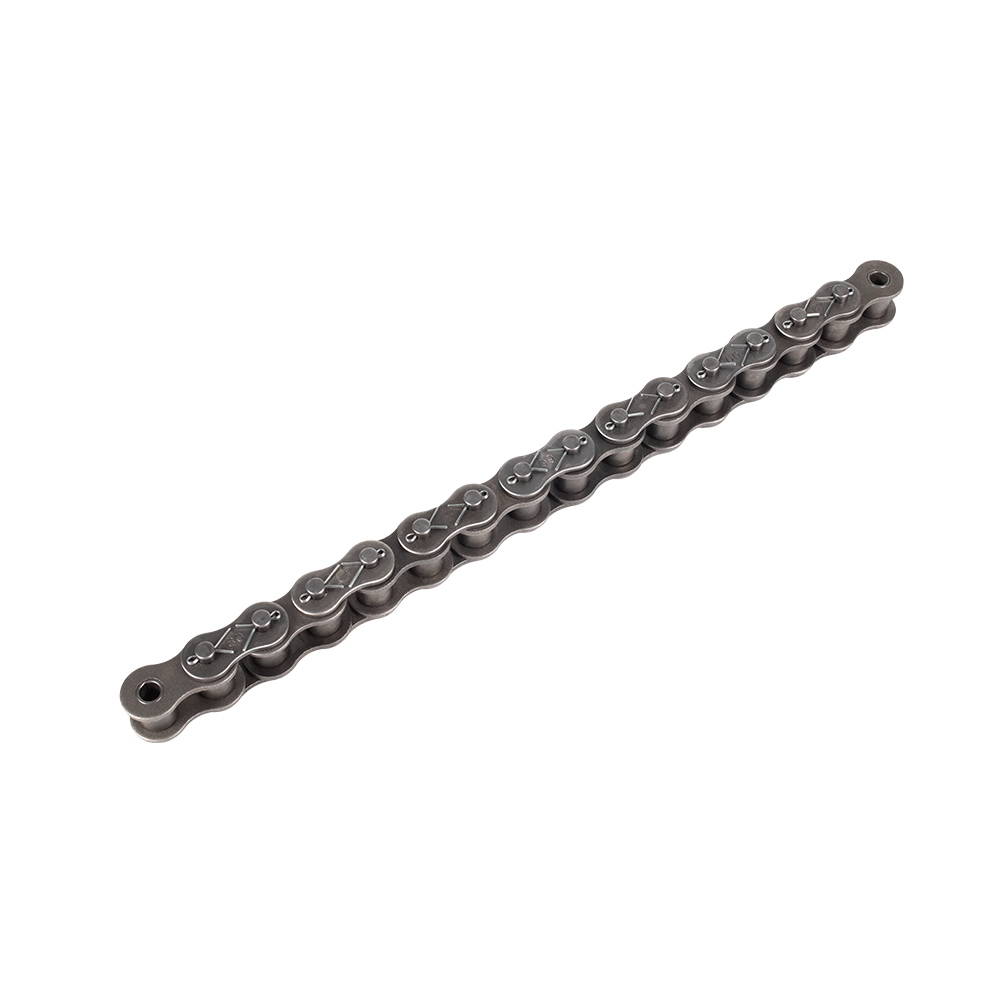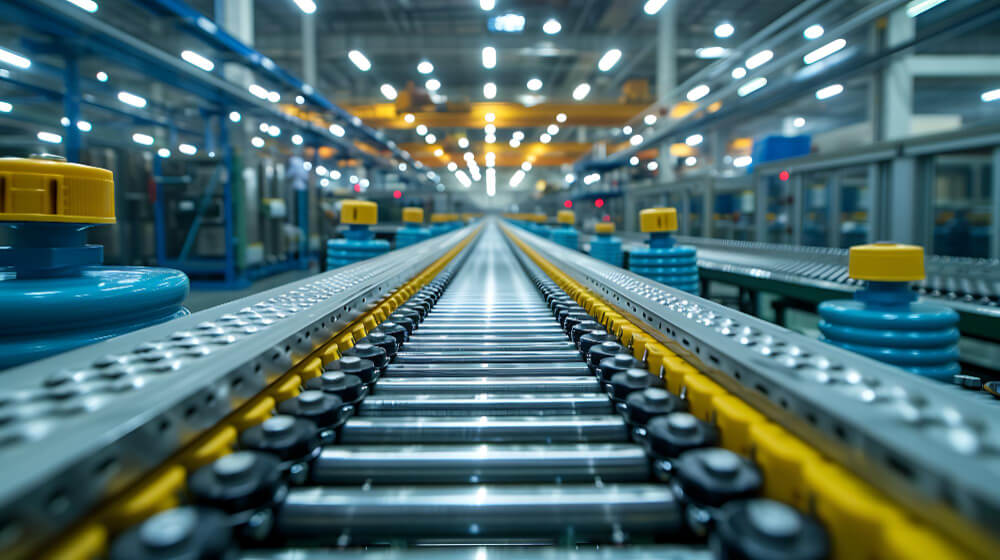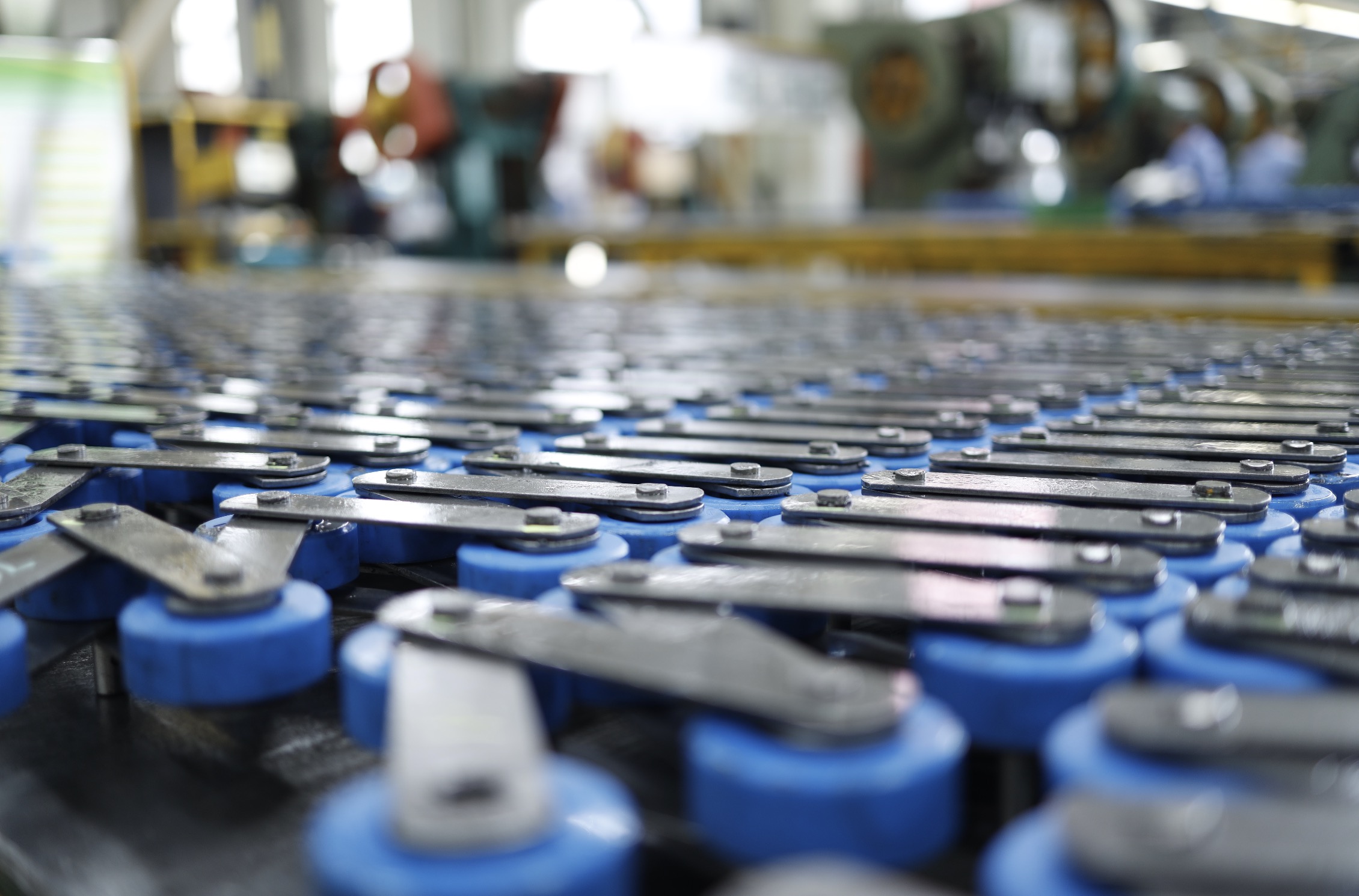Chain drives are used in power transmission to transfer rotary motion from one shaft to another. They consist of an endless series of chain links meshing with toothed sprockets for precision timing.
They transmit power from the drive shaft to the driven shaft at a constant ratio, as well as transmit motion over short center distances.
What is a chain drive?
A chain drive is a mechanism that transmits mechanical power from one place to another using a chain.
It is commonly used in various machines and vehicles to transfer rotational energy efficiently.
The primary components of a chain drive system include a chain, sprockets (or gears), and sometimes additional components like tensioners.
Types of Industrial Chain
1. Roller Chain
Roller chains are the most prevalent industrial chain type and find application across many industries. They transfer power from one section of a conveyor system to the next through linked chains and sprockets.
Roller chains are an extremely standardized and specialized type of chain that uses stringent specifications in the selection of raw materials, clearances, and heat treatments to achieve desired strength and durability. As such, they’re best suited for clean indoor environments where pins and bushings can remain free from airborne dust particles and debris.
2. Silent Chain
The silent chain (also referred to as an inverted tooth chain) transmits power at high speeds while remaining soundless. This type of chain consists of flat plates stacked in rows and connected through one or more pins, increasing load-bearing capacity, tensile strength, and chain width with each link’s number of flat plates.
Silent chains have many applications, from medium to large motorcycle and automobile engines, transfer case drive in four-wheel-drive vehicles, and primary drive between engine and transmission to other high-speed tasks. Furthermore, their nonslip surface makes them suitable for conveying purposes due to their resistance to heat and friction.
3. Sprocket Chain
Sprocket chains are used in conveyor drives, printing presses, and industrial machinery to transmit movement and force from one sprocket to the next.
Sprockets come in either single or double pitch, depending on the number of teeth needed to fit between roller-pin centers on a chain. Chains with larger pitch diameters require sprockets with similar size teeth, while smaller chains with shorter distances between roller pin centers need smaller teeth.
Sprockets come in a range of materials, such as steel and aluminum. Some can be hardened for extended sprocket life, while others feature wear indicators on some teeth to alert you when replacement is necessary.
4. Idler Chain
Idler sprockets are a type of gear used in power transmission systems to maintain chain tension, change its direction or position it away from obstacles. They usually spin freely on a shaft that does not transmit power, helping reduce vibration or wear on other components.
The invention eliminates this issue by replacing the toothed-sprocket idler with a resilient roller that absorbs highs and smoothes out lows.
5. Conveyor Chain
Conveyor chains are essential tools in the transportation of goods from one location to another. Generally made out of steel, these can also be constructed out of wood or other materials.
Conveyor chains come in a range of strengths, loading capacities, and pitches. Certain varieties are better suited for certain applications than others.
Conveyor chains are typically produced to national and international standards, such as British Standard (BS) conveyor chains. Additionally, there are ISO versions available that are commonly used in Europe.
Uses of Chain Drive
Chain drives are used in a wide array of applications across different industries due to their versatility and reliability.
The question about how chain drives work also relies on where they are specifically used, such as the following:
Bicycles and Motorcycles
Chain drives are crucial in transmitting power from pedals or engines to the wheels, allowing for efficient motion.
In bicycles, the chain drive connects the front chainring to the rear sprocket, enabling the rider to convert pedaling action into forward movement.
Motorcycles use more robust chains to handle higher speeds and power outputs.
Automobiles
Timing chains are used to synchronize the rotation of the crankshaft and camshaft in internal combustion engines, ensuring precise engine timing.
This synchronization is critical for engine performance, as it affects the opening and closing of the engine’s valves.
Chain drives are also found in transfer cases and drive shafts in some four-wheel-drive and all-wheel-drive vehicles.
Industrial Machinery
Chain drives power conveyors, mixers, and other machinery, providing reliable performance in manufacturing and processing plants.
They are used in assembly lines to move products through various stages of production, ensuring efficient and continuous operation.
Agricultural Equipment
Tractors, harvesters, and other farm machinery utilize chain drives to transfer power efficiently under harsh conditions.
These chains are designed to withstand exposure to dirt, debris, and varying weather conditions, ensuring reliable performance in the field.
Material Handling
Conveyor systems in warehouses and distribution centers rely on chain drives for moving goods and materials.
These systems are crucial for the efficient transport of packages, pallets, and bulk materials, often over long distances.
Mining and Quarrying
Chain drives are used in heavy-duty mining equipment such as draglines, loaders, and conveyors.
These chains are built to handle extreme loads and abrasive conditions, providing the necessary durability and strength for mining operations.
Food and Beverage Industry
Chain drives are used in food processing and packaging machinery, where hygiene and corrosion resistance are critical.
Stainless steel and plastic chains are commonly used in these applications to meet sanitary standards and withstand frequent cleaning.
Lifting and Hoisting
Chain drives are integral to the operation of cranes, hoists, and elevators. Leaf chains, in particular, are used for their high tensile strength and ability to lift heavy loads safely and reliably.
Textile Industry
In textile manufacturing, chain drives are used in machines such as looms and spinning machines to ensure precise and efficient operation.
These chains help in the accurate control of tension and speed, which is essential for producing high-quality textiles.
How to Choose the Right Chain Drive
Selecting the appropriate chain drive for a specific application involves considering several critical factors:
Load Requirements
Determine the maximum load the chain will need to handle. This includes both the weight of the materials being moved and any additional forces exerted during operation.
Speed
Assess the operational speed of the system. High-speed applications may require silent chains to minimize noise and vibration, while slower systems may use roller or conveyor chains.
Environmental Conditions
Consider the operating environment. For example, corrosive environments like food processing may benefit from stainless steel or plastic chains, while harsh outdoor conditions might require engineered steel chains.
Alignment and Space Constraints
Ensure the chain drive system fits within the spatial limitations of the equipment. Misalignment can cause premature wear and failure, so precise measurements and alignment are crucial.
Maintenance and Lubrication
Evaluate the maintenance requirements. Some chains need regular lubrication and tension adjustments, while others, like sealed roller chains, require less frequent maintenance.
Cost
Balance the initial cost with the long-term benefits. While high-quality chains may have a higher upfront cost, their durability, and reduced maintenance needs can offer cost savings over time.
Compatibility with Sprockets
Ensure the chain is compatible with the sprockets in the system. The pitch, width, and diameter of the sprockets must match the chain specifications to ensure smooth operation.
Suzhou Universal Technology produces industrial machinery parts, such as chains, sprocket wheels, transmissions, bearings, head gaskets, and more. They sell their products worldwide.
The Company strives to offer reliable and quality-driven products to customers worldwide. It offers customized solutions based on clients’ technical requirements.





